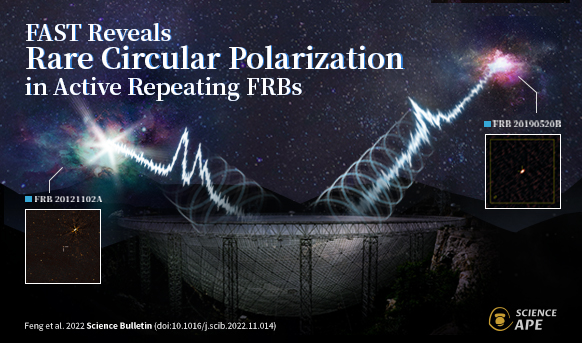Precise FAST Observations Reveal Circular Polarization in Active Repeating Fast Radio Bursts

This image is the artist impression of FAST detected the circular polarization from two active repeating FRBs with PRSs. (Credit: ScienceAPE, Di Li)
A research team led by Prof. LI Di from the National Astronomical Observatories of the Chinese Academy of Sciences (NAOC) has revealed circular polarization in active repeating fast radio bursts based on precise observations of the Five-hundred-meter Aperture Spherical radio Telescope (FAST).
Their findings were published in Science Bulletin on Dec. 26, 2022.
Fast radio bursts (FRBs) are the most luminous radio flashes in the universe. The estimated equivalent energy of one FRB event can rival that of the Sun in a whole day or even a month to a year.
Since the first FRB was reported in 2007, more than 600 FRB sources have been discovered, the majority of which have only been detected once. Less than 5% of all FRBs have repeated bursts, among which less than 10 can be described as active.
As one of the basic properties of electromagnetic waves, polarization carries critical information about FRBs' intrinsic properties and their environments. Many common light sources, including incandescent light bulbs and most stars such as our Sun, emit unpolarized light. Linear polarization has been detected in almost all repeating FRBs. Circular polarization, however, remains relatively rare. Only one repeating FRB, namely FRB20201124A, has been reported with circular polarization.
FRB20121102A is the first known repeater. FRB20190520B, discovered by the Commensal Radio Astronomy FAST Survey (CRAFTS), is the first persistently active repeater known. They are the only repeaters found to be associated with persistent radio sources (PRSs), which could be a sign of their youthfulness and related to their hyper-active nature. FAST managed to capture extremely active episodes for these two FRBs, which has allowed for precise characterization of their polarization.
Through systematic data analysis, the researchers detected circular polarization in less than 5% of the bursts from both FRBs. The maximum degree of circular polarization was as much as 64%. The large degree of circular polarization disfavors multi-path propagation as the cause. The currently viable hypotheses include Faraday conversion and/or a radiation mechanism intrinsic to the source.
As of now, circular polarization occurs apparently more often in non-repeaters than in repeaters. The conditions for generating circular polarization in repeating FRBs should thus be rarer.
This work increases the number of repeating FRBs with circular polarization from one to three. The detection of circular polarization in FRB20121102A, 20190520B, and 20201124A may suggest that circular polarization is a common trait, although occurring sporadically, in repeating FRBs.
Further systematic and precise characterization of polarization by FAST will shed new light on the emission mechanism of FRBs and eventually help reveal the origin of such mysterious events in our dynamic Universe.
This paper can be accessed at https://www.sciencedirect.com/science/article/pii/S209592732200531X